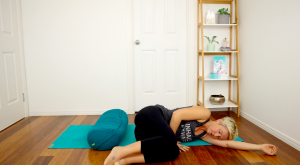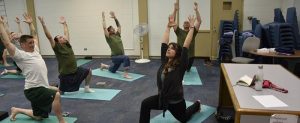Improve Posttraumatic Stress Disorder (PTSD) with Mindfulness
By John M. de Castro, Ph.D.
“As a clinical psychologist working at the VA, I found that veterans who also had a practice, whether it be meditation or mindful movement, had better outcomes,” – Dan Libby
Experiencing trauma is quite common. It has been estimated that 60% of men and 50% of women will experience a significant traumatic event during their lifetime. But only a fraction will develop Post-Traumatic Stress Disorder (PTSD). But this still results in a frightening number of people with 7%-8% of the population developing PTSD at some point in their life. For military personnel, it’s much more likely for PTSD to develop with about 11%-20% of those who have served in a war zone developing PTSD.
PTSD involves a number of troubling symptoms including reliving the event with the same fear and horror in nightmares or with a flashback. PTSD sufferers avoid situations that remind them of the event this may include crowds, driving, movies, etc. and may avoid seeking help because it keeps them from having to think or talk about the event. They often experience negative changes in beliefs and feelings including difficulty experiencing positive or loving feelings toward other people, avoiding relationships, memory difficulties, or see the world as dangerous and no one can be trusted. Sufferers may feel hyperarousal, feeling keyed up and jittery, or always alert and on the lookout for danger. They may experience sudden anger or irritability, may have a hard time sleeping or concentrating, may be startled by a loud noise or surprise.
Obviously, these are troubling symptoms that need to be addressed. There are a number of therapies that have been developed to treat PTSD. One of which, mindfulness training has been found to be particularly effective. The Mindfulness-based Stress reduction (MBSR) program involves meditation, yoga, body scan and group discussion. It has been found to improve the symptoms of PTSD.
In today’s Research News article “A Multisite Randomized Controlled Trial of Mindfulness-Based Stress Reduction in the Treatment of Posttraumatic Stress Disorder.” (See summary below or view the full text of the study at: https://www.ncbi.nlm.nih.gov/pmc/articles/PMC8189576/ ) Davis and colleagues recruited veterans who were diagnosed with Post-Traumatic Stress Disorder (PTSD) and randomly assigned them to receive 8 weeks of Mindfulness-based Stress reduction (MBSR) or Present-Centered Group Therapy (PCGT). PCGT was a control condition that contained many of the non-specific, social effects and expectations contained in MBSR, but discussions were on current events and everyday problems but not trauma. They were measured before and after treatment and 7 weeks later for PTSD symptoms, mindfulness, and health.
They found that at the 7-week follow up assessment both groups had significant reductions in PTSD severity as assessed in a clinical interview and increases in mindfulness and did not statistically differ. For both groups the greater the increase in mindfulness that occurred over treatment the greater the reductions in clinically assessed PTSD severity. On the other hand, there were significantly greater reductions in self-reported PTSD symptoms in the MBSR group.
It is surprising that Present-Centered Group Therapy (PCGT) produced such significant improvements. This demonstrates the power of non-specific factors in therapy. Factors such as “decreased isolation, shared support, shared positive experiences with other veterans with similar symptoms, experience of an atmosphere of safety, and awareness and objectivity of how PTSD affects one’s daily life” produce major improvements in PTSD. In most research the control condition doesn’t contain these components and as a result the intervention effects appear quite large.
But even with the strong control condition employed here, Mindfulness-based Stress reduction (MBSR) produced significantly greater improvements in the veterans self-assessments of their symptoms. One of the reasons that Present-Centered Group Therapy (PCGT) produced significant improvements is that it increased mindfulness. It has been previously found that increases in mindfulness produces improvements in the symptoms of PTSD. So, increasing mindfulness, no matter what technique accomplishes it, may be the key to improving the symptoms of PTSD.
So, improve Posttraumatic Stress Disorder (PTSD) with mindfulness.
“Both MBSR and present-centered group therapy appear to have beneficial effects in treating PTSD in veterans, with greater improvement observed in self-reported PTSD symptoms among the MBSR group.” – Mitch Mirkin
CMCS – Center for Mindfulness and Contemplative Studies
This and other Contemplative Studies posts are also available on Google+ https://plus.google.com/106784388191201299496/posts and on Twitter @MindfulResearch
Study Summary
Davis, L. L., Whetsell, C., Hamner, M. B., Carmody, J., Rothbaum, B. O., Allen, R. S., Al Bartolucci, A., Southwick, S. M., & Bremner, J. D. (2019). A Multisite Randomized Controlled Trial of Mindfulness-Based Stress Reduction in the Treatment of Posttraumatic Stress Disorder. Psychiatric research and clinical practice, 1(2), 39–48. https://doi.org/10.1176/appi.prcp.20180002
Abstract
Objective:
Posttraumatic stress disorder (PTSD) is often difficult to treat, and many patients do not achieve full remission. Complementary and integrative health approaches, such as mindfulness meditation, are intended to be integrated with evidence-based treatment. This study examined the efficacy of mindfulness-based stress reduction (MBSR) in the treatment of PTSD in U.S. military veterans.
Methods:
Veterans with a diagnosis of PTSD (N=214) were randomly assigned to either 90-minute group MBSR or present-centered group therapy (PCGT) for eight weeks. Follow-up assessments were obtained at baseline and weeks 3, 6, 9 (primary endpoint), and 16.
Results:
Both the MBSR and PCGT groups achieved significant improvement in PTSD as measured by the Clinician-Administered PTSD Scale for DSM-IV (CAPS-IV), with no statistically significant differences between groups. However, compared with PCGT, the MBSR group showed a statistically significant improvement in PTSD on the self-reported PTSD Checklist for DSM-IV over the nine weeks. This difference was not maintained posttreatment, at week 16. Strengths of the study include its large sample size, multisite design, active control group, single-blind outcome ratings, fidelity monitoring, large minority representation, and randomized approach. The study was limited by its high attrition rate and low representation of women.
Conclusion:
Both MBSR and PCGT appear to have beneficial effects in treating PTSD in veterans, with greater improvement observed in self-reported PTSD symptoms in the MBSR group. No differences between groups were observed on the CAPS-IV scale.
https://www.ncbi.nlm.nih.gov/pmc/articles/PMC8189576/









